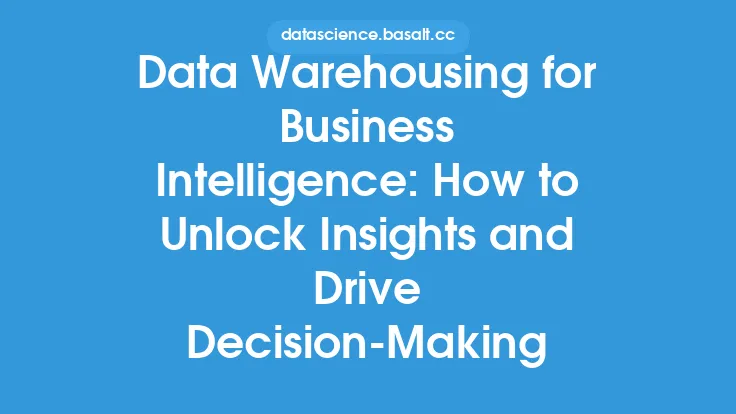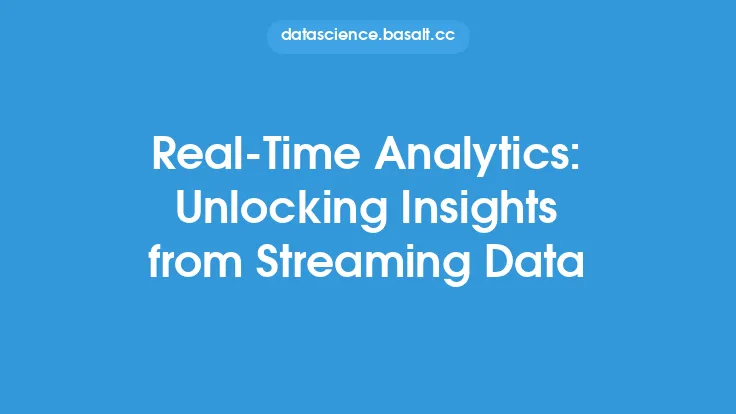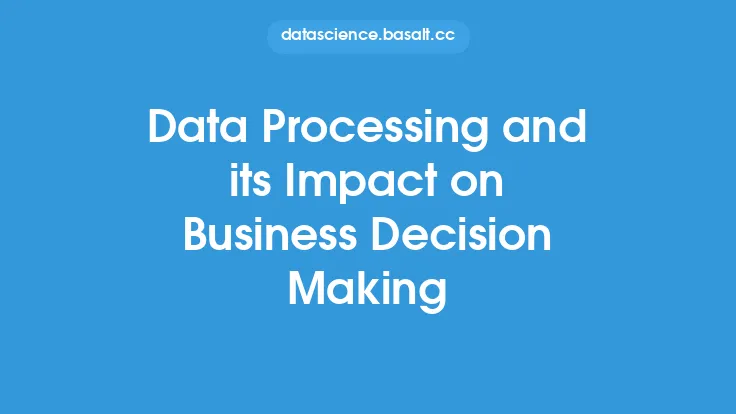In today's fast-paced business environment, organizations are constantly seeking ways to stay ahead of the competition and make informed decisions quickly. One key factor in achieving this goal is the ability to analyze and act on data in real-time. A well-designed data architecture is crucial for enabling real-time analytics and decision making, as it provides the foundation for collecting, processing, and analyzing large volumes of data from various sources. In this article, we will delve into the world of data architecture for real-time analytics and decision making, exploring the key components, technologies, and best practices involved.
Introduction to Real-Time Analytics
Real-time analytics refers to the ability to analyze and act on data as it is generated, rather than relying on historical data. This approach enables organizations to respond quickly to changing market conditions, customer behavior, and other factors that can impact their business. Real-time analytics involves the use of advanced technologies such as stream processing, event-driven architecture, and in-memory computing to process and analyze large volumes of data in real-time. The benefits of real-time analytics include improved decision making, enhanced customer experience, and increased operational efficiency.
Key Components of a Real-Time Data Architecture
A real-time data architecture typically consists of several key components, including data ingestion, data processing, data storage, and data analytics. Data ingestion involves collecting data from various sources, such as sensors, social media, and applications, and transporting it to a central location for processing. Data processing involves transforming and analyzing the data in real-time, using technologies such as Apache Kafka, Apache Storm, and Apache Flink. Data storage involves storing the processed data in a scalable and fault-tolerant manner, using technologies such as NoSQL databases and data lakes. Data analytics involves analyzing the stored data to gain insights and make informed decisions, using technologies such as Apache Spark, Python, and R.
Technologies for Real-Time Data Processing
Several technologies are available for real-time data processing, including Apache Kafka, Apache Storm, Apache Flink, and Apache Spark. Apache Kafka is a distributed streaming platform that enables real-time data processing and event-driven architecture. Apache Storm is a real-time processing system that enables the processing of large volumes of data from various sources. Apache Flink is a platform for distributed stream and batch processing, which enables the processing of large volumes of data in real-time. Apache Spark is a unified analytics engine that enables the processing of large volumes of data in real-time, using technologies such as Spark Streaming and Spark SQL.
Data Storage Options for Real-Time Analytics
Several data storage options are available for real-time analytics, including relational databases, NoSQL databases, and data lakes. Relational databases, such as Oracle and MySQL, are suitable for storing structured data and supporting ACID transactions. NoSQL databases, such as MongoDB and Cassandra, are suitable for storing unstructured and semi-structured data and supporting high scalability and availability. Data lakes, such as Hadoop and Amazon S3, are suitable for storing large volumes of raw data and supporting data exploration and discovery.
Best Practices for Designing a Real-Time Data Architecture
Several best practices are available for designing a real-time data architecture, including designing for scalability and fault tolerance, using cloud-based services, and implementing data governance and security. Designing for scalability and fault tolerance involves using distributed systems and load balancing to ensure high availability and performance. Using cloud-based services involves leveraging cloud-based platforms and tools to reduce costs and improve scalability. Implementing data governance and security involves ensuring data quality, integrity, and security, using technologies such as data encryption and access control.
Real-Time Data Analytics Tools and Techniques
Several real-time data analytics tools and techniques are available, including data visualization, predictive analytics, and machine learning. Data visualization involves using tools such as Tableau and Power BI to visualize data and gain insights. Predictive analytics involves using tools such as R and Python to build predictive models and forecast future events. Machine learning involves using tools such as scikit-learn and TensorFlow to build machine learning models and improve decision making.
Case Studies and Examples
Several case studies and examples are available that demonstrate the benefits of real-time data architecture for analytics and decision making. For example, a leading retail company used Apache Kafka and Apache Spark to build a real-time data pipeline that enabled them to analyze customer behavior and improve sales. A leading financial services company used Apache Flink and Apache Cassandra to build a real-time data platform that enabled them to detect and prevent fraud. A leading healthcare company used Apache Storm and Apache HBase to build a real-time data platform that enabled them to analyze patient data and improve treatment outcomes.
Conclusion
In conclusion, a well-designed data architecture is crucial for enabling real-time analytics and decision making. The key components of a real-time data architecture include data ingestion, data processing, data storage, and data analytics. Several technologies are available for real-time data processing, including Apache Kafka, Apache Storm, Apache Flink, and Apache Spark. Several data storage options are available, including relational databases, NoSQL databases, and data lakes. Best practices for designing a real-time data architecture include designing for scalability and fault tolerance, using cloud-based services, and implementing data governance and security. Real-time data analytics tools and techniques include data visualization, predictive analytics, and machine learning. By following these best practices and using these technologies and tools, organizations can build a real-time data architecture that enables them to make informed decisions and stay ahead of the competition.





